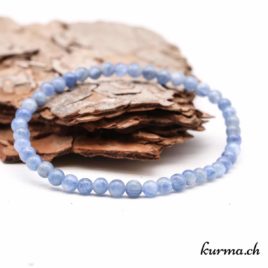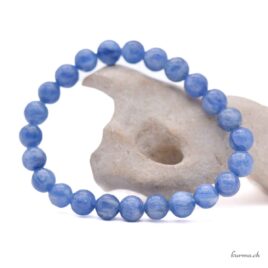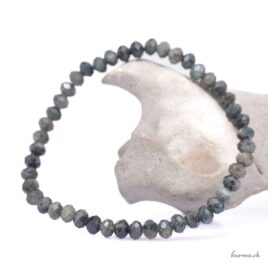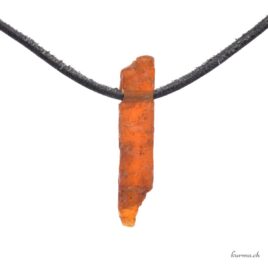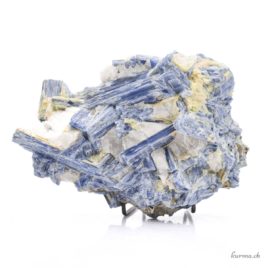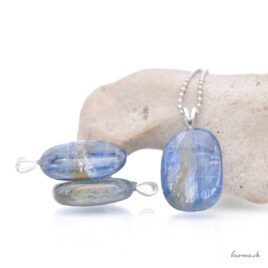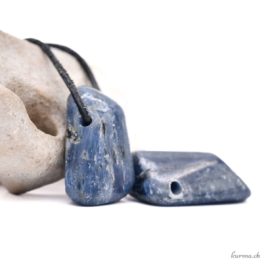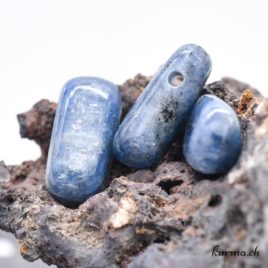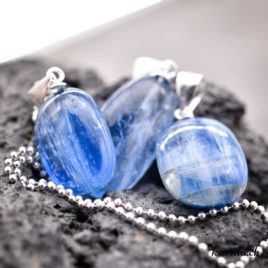Cyanite - Blue Disthene
gemstones in necklaces pendants, bracelets and minerals
Cyanite or Kyanite is a blue Disthenite (from the Greek di and sthenos: "double strength") composed of aluminum silicate.
It is an anisotropic stone: the hardness of its unique crystalline structure varies according to the direction of the crystal.
In lithotherapy, it is a stone against anxiety and to aid self-expression.
What are the lithotherapy virtues of cyanite?
Its virtues are spiritual and energetic. It balances the chakras to calm fears and anxieties and, by helping to overcome emotional blockages and clarifying thought, also promotes easy communication.
The origins of the Cyanite symbol
Its mystical and protective properties have spanned the centuries.
Among the ancient Greeks, for example, it was an adjunct to diplomatic missions: its power fluidified and clarified messages and all communication in an honest manner.
According to legend, the sword of Archangel Michael, who struck down dragons, was set with Cyanites; these blue crystals symbolized his strength, signifying justice and truth.
Its properties and benefits in lithotherapy
When you're feeling unsettled, confused or frustrated, when you're not sure which direction is right for you, when you're feeling stress or anxiety, Cyanite can help. It's a stone that encourages and helps you to clarify your inner turmoil, to tidy up and sort out the jumble created by your intrusive thoughts, so that you can take a clearer look at the problems or situations that affect you, your life, your choices and your everyday life.
Cyanite helps you to draw on your own resources to find solutions, to be the actor of a necessary change, and not the victim of a distressing situation.
It encourages clarity of mind, but also clarity of voice. It helps you to express yourself in a clear and poised way. It's surely the ideal companion for you if you're having trouble finding your words, setting your voice with the right timbre, being inspired or confident in your speeches.
This stone is well suited to shy people who find it stressful to express themselves outside their circle of trust, to angry people who lose their temper easily, to those and are always imagining a thousand and one difficulties (which end up becoming excuses for not achieving their goals) or to people who are sensitive to stress.
Cyanite is often recommended for people suffering from mental handicaps or psychic pathologies.
How to use Cyanite
Wear Cyanite around your neck when you need to speak in public and want to express yourself clearly.
Need to clear your head? Relax with a Cyanite on your forehead.
Do you feel that an area of your body is energetically imbalanced? Place a Cyanite on the area in question.
In meditation, it is reputed to aid astral travel and a connection with spirit guides.
Where to place a Cyanite?
Cyanite in your living space will make you want to tidy up and sort out! It's ideal if you find it hard to put things away as you go and and you easily accumulate useless things.
In your bedroom, it can help you sleep; on your desk, it's excellent for stimulating your intellect; and in a treatment room, the way it amplifies spiritual healing energies is always welcome.
To enjoy the benefits of Cyanite on a daily basis, wear your stone against you, as a piece of jewelry, in your pocket or in your bra.
Which crystals amplify the virtues of Cyanite in lithotherapy?
- Combined with Amethyst, it helps open the third eye chakra and promotes a full spiritual connection.
- With Labradorite to strengthen transformative energies and protect you from negative ones.
- Quartz prase for mental clarity.
- Combined with Selenite to charge your stone and a beautiful purification when you take action.
Cyanite purification
Refilling / cleaning
Moon, fumigation, running water, breath, intention, singing bowl, form waves, prayers...Chakras
5e and 6e chakras - Gorge and 3ᵉ oeilAstrological signs
Sagittarius, Pisces and VirgoElement
AirCyanite mineralogy
Cyanite, also known as kyanite, is an aluminosilicate mineral that forms mainly in metamorphic rocks under conditions of high pressure and temperature. It is also found in schists and gneisses, alongside minerals such as staurolite, andalusite and sillimanite.
The crystals are elongated and blade-shaped, and range in color from pale to deep blue, with gray, green and white variations.
It is an anisotropic crystal, which means that its physical properties, such as hardness, vary according to the direction of the crystal. Its Mohs hardness can vary from 4-4.5 (when scratched parallel to its long axis - the direction of the blade) and 6.5-7 (when scratched perpendicular to this axis). This property is unique among common crystals.
Cyanite is found in many countries, including the United States, India, Brazil, Nepal, Kenya, Zimbabwe, Austria...
Lithotherapy
- Element(s) :
- Zodiac(s) :
- Pisces, Sagittarius, Virgo
- Purification :
- Singing bowl, Water, Fumigation, Moon, Form waves, Breath
- Physics :
- Brain, Vocal chords
- Emotional :
- Anxiety, Clarity, Anger, Self-confidence, Hypersensitivity, Stress, Balance
- Spiritual :
- Alignment, Harmony, Intuition, Limits, Meaning of life
- Miscellaneous :
- Creativity
Mineralogy
- Hardness :
- 6.5-7.0 crosswise to Cristal, 4.0-4.5 lengthwise
- Moths scale:
- 4, 6, 7
- Strunz classification :
- Silicate
- Crystalline system :
- Triclinique
- Chemical element :
- Al, O, Si
- Line color :
- White
- Density :
- 3.53-3.69
- Cleavage :
- Complete
- Fracture:
- Fibrous, friable
- Transparency :
- Transparent to translucent
- Refringence :
- a=1.712-1.718, b=1.72-1.725, g=1.727-1.734
- Birefringence :
- Biaxial (-); 0.012 - 0.016, 2V = 84.2°.
- Fluorescence :
- Yes, and luminescent
- Colors :
- Blue, white, grey, green, yellow, pink, black, colorless
- Magnetism :
- no
- Radioactivity :
- no
Continue your visit
*Please note! Some minerals may be toxic and must not be licked or ingested (as such or in the form of powder, elixir or stone water) or be in prolonged contact with the skin or mucous membranes.
*The information on the stones described here are general indications based on our research and experience, and are not exhaustive.
Reproduction in whole or in part of this content is prohibited. More info



